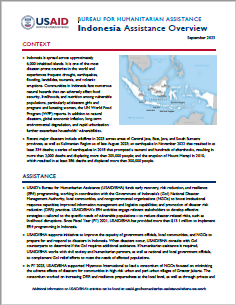Indonesia
USAID is providing humanitarian aid to people affected by a magnitude 7.5 earthquake and tsunami. Photo credit: AFP/Jewel Samad
Key Developments
USAID's Bureau for Humanitarian Assistance (USAID/BHA) supports initiatives to improve the capacity of government officials, local communities, and non-governmental organizations (NGOs) to prepare for and respond to disasters in Indonesia.
In addition to disaster response, USAID/BHA funds early recovery, risk reduction, and resilience programming.
USAID/BHA provided nearly $2.9 million in early recovery, risk reduction, and resilience programming across Indonesia in fiscal year 2022. This included supporting NGOs to work in concert with authorities to train first responders to more effectively deliver humanitarian assistance during emergencies; implement community based programs to promote climate-resilient agriculture; and raise local awareness of disaster risk mitigation and response measures through trainings on first aid and psychosocial support in emergencies, with a particular focus on women and girls' empowerment, and school based disaster preparedness assistance and messaging, among other topics.
Background
Indonesia is one of the most disaster prone countries in the world, experiencing frequent drought, earthquakes, flooding, landslides, tsunamis, and volcanic eruptions. Spread across approximately 6,000 inhabited islands, communities in Indonesia face numerous natural hazards and have varying levels of disaster response capacity. Climate risks, environmental degradation, and rapid urbanization exacerbate these risks.
Recent major disasters include an earthquake in November 2022 that resulted in at least 334 deaths; a series of earthquakes in 2018 that prompted a tsunami and hundreds of aftershocks, resulting in more than 2,000 deaths and displacing more than 205,000 people; the eruption of Mount Merapi in 2010, which resulted in at least 386 deaths and displaced more than 300,000 people.


